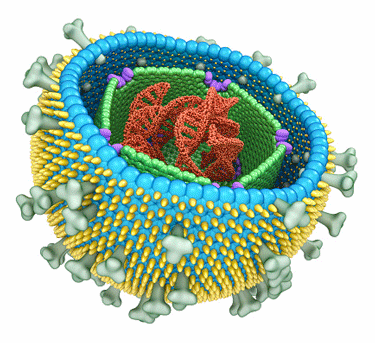

Viral Mystery
“I’ve been a co-author in almost 500 papers. This one is more important than all of the rest put together. It is a capstone to a career in medical research,” Harley

The Epstein-Barr virus may be triggering scores of autoimmune diseases – as well as ME/CFS
I thought I sensed some awe in Ron Davis’s voice as he pushed for more understanding of the Epstein-Barr virus’s (EBV’s) effects in ME/CFS during a talk at the Brain Science conference. Davis has not to my knowledge found much evidence of EBV reactivation in the severe ME/CFS patient study – a surprise – but he is very interested in what happened during the initial EBV infection that has triggered chronic fatigue syndrome (ME/CFS) in so many people.
He’s not alone in his “admiration” for the virus. Simmaron’s Advisor, Dr. Daniel Peterson, whose clinical practice and research stemmed from an outbreak in the Lake Tahoe region of Chronic Fatigue Syndrome, has tracked EBV in patients for decades, noting very high titers to EBV and other herpes viruses in subsets of patients.
It’s not surprising that these two important figures have had their eyes on EBV. The bug is, after all, kind of in a league of its own. The 50th anniversary of its discovery was recently celebrated with numerous reviews. How many viruses can you say that about?
Discovered in 1966 by Anthony Epstein and Yvonne Barr, EBV was the first human virus shown to cause cancer. The sequencing of its large genome in 1995 helped launch the genomic era. One of the more massive and complicated viruses, it – like the other herpesviruses – able to avoid elimination: once EBV infects your B-cells, it’s in your body to stay. It’s able to effectively hide from the immune system and reactivate just enough so that when the infected B-cells die it can move on to other cells.
While we’re well equipped to ward off EBV when we’re young – it usually produces only minor symptoms – we rather quickly have trouble dealing with it. Encountering EBV as an adolescent or adult (infectious mononucleosis, glandular fever) – as increasingly happens in our germ-phobic age – often means months of convalescence as our immune systems struggle to ward off this powerful virus.
The problems don’t stop there. We know that infectious mononucleosis (IM) is a common trigger of ME/CFS but coming down with IM/glandular fever in adolescence also increases the risk of coming down with multiple sclerosis 2-4 fold and lupus by fifty percent. EBV’s ability to remain latent in the body presents major problems for transplant patients with compromised immune systems.
THE Autoimmune Virus?
A big question concerning EBV is how a virus that’s essentially been latent for decades could trigger serious diseases like MS and lupus. We now may have the answer. Last week, a seminal paper in pathogen research demonstrated how EBV is able to trigger autoimmune diseases later in life and could conceivably play a role in ME/CFS. The rather hum drum title of the paper “Transcription factors operate across disease loci with EBNA2 implicated in autoimmunity” in the Nature Genetics Journal hardly hinted at the possibilities the paper presents.
EBV consists of several proteins of which EBNA-2 is one. EBNA-2 is EBV’s main viral transactivator; i.e. it’s a transcription factor that turns on genes in an infected cell that help EBV to survive. Essentially EBNA-2 allows EBV to hijack a cell’s genetics and put them to its own use.
The study – produced by researchers at Cincinnati Children’s Hospital – demonstrated that once EBV infects B-cells, it turns on genes that have been identified as risk factors for a boatload of autoimmune diseases. Even though the virus is “latent”; i.e. it’s not replicating – its transcription factor is still active – altering the expression of our genes.
The genes that it affects just happen to be the same genes that increase the risk of developing lupus, multiple sclerosis (MS), rheumatoid arthritis (RA), juvenile idiopathic arthritis (JIA), inflammatory bowel disease (IBD), celiac disease, and type 1 diabetes. Apparently, decades of genetic assault from EBV’s transcription factor can set the stage or at least contribute to many autoimmune diseases.
Chronic diseases are usually caused by a variety of genetic and environmental factors. Because not everyone with these transcription factors comes down with a chronic illness, other factors must play a role. The authors believe, though, that the gene expression changes induced by the virus in the B cells could account for a large number of people with lupus and MS who fall ill.
“In lupus and MS, for example, the virus could account for a large percentage of those cases. We do not have a sense of the proportion in which the virus could be important in the other EBNA2-associated diseases,” Harley
Chronic Fatigue Syndrome and EBV/Infectious Mononucleosis – A Short History
Researchers have been trying to figure out – mostly unsuccessfully- what the heck happens to plunge people with infectious mononucleosis into ME/CFS.
White found IM/glandular fever to be a particularly strong trigger of ME/CFS and concluded that the pathogen was probably responsible for about 3,000 new cases of ME/CFS yearly in the U.K.A 1992 Swedish study, though, concluded that whatever happened in ME/CFS, it was not due to EBV reactivation.
In 2010 Taylor found reduced peak oxygen consumption during exercise in adolescents with ME/CFS after IM compared to IM patients who had recovered. Broderick’s finding of altered cytokine networks associated with Th17 in ME/CFS patients following IM suggested the bug had produced immune dysregulation. Glaser’s 2005 study suggested that an EBV-encoded enzyme produced by a non-replicating form of EBV was causing symptoms in ME/CFS.
Lerner’s 2012 study suggested that antibodies to two EBV-produced proteins were commonly present in ME/CFS – suggesting that a prolonged immune reaction to EBV was occurring in ME/CFS. In 2014 Loebel/Scheibenbogen suggested that ME/CFS patients were having trouble controlling the early stages of EBV reactivation. Loebel’s 2017 follow-up study suggested that ME/CFS patients’ immune systems were overreacting to an EBV-produced protein and that autoimmunity might be involved.
Leonard Jason’s ongoing IM college student study will hopefully provide clues why some people never recover from it. He’s completing data analysis of a study examining college students who came down with infectious mononucleosis and then ME/CFS. So far Jason has found that at least 4-5% of college students come down with IM while at school.
Treatment Implications
Interestingly, several drugs that are available can block some of the transcription factors EBV has inserted into B-cells. (I was unable to determine what they are.) The authors also hope the study will help spur more efforts to produce an EBV vaccine.
Opportunities for Collaboration Open Up
The big question awaiting ME/CFS now is if the abnormal transcription factors associated with the autoimmune diseases in the recent paper are present. The good news is that a study determining that appears to be within reach of an ME/CFS researcher with the technical ability and funds. In an unusual move, the Cincinnati researchers are making the computer code they used available to other researchers.
“We are going to great lengths to not only make the computer code available, but all of the data and all of the results. We think it’s an interesting approach that could have implications for many diseases, so we’re contacting experts on the various diseases and sharing the results and seeing if they want to collaborate to follow-up on them.” Weinrauch “This discovery is probably fundamental enough that it will spur many other scientists around the world to reconsider this virus in these disorders” Harley

These researchers are so jazzed by their results that they’ve dropped all pretenses of modesty. The study results need to be validated, but because EBV is so common and is potentially linked to so many autoimmune (and other diseases), it has the potential to rewrite our understanding of how autoimmune diseases arise. The lead author of the study, John Harley, said:
“I’ve been a co-author in almost 500 papers. This one is more important than all of the rest put together. It is a capstone to a career in medical research,” Harley
One of the senior authors of the study stated:
“This same cast of characters is a villain in multiple immune-related diseases. They’re playing that role through different ways, and doing it at different places in your genome, but it’s the same sinister characters. So if we could develop therapies to stop them from doing this, then it would help multiple diseases.” Matthew Weirauch


 Health Rising’s Quickie Summer Donation Drive is On!
Health Rising’s Quickie Summer Donation Drive is On!



The most effective treatment ever invented to help the immune system kill viruses and bacteria was Ultra Violet Blood Irradiation. To bad members of Big Medicine followed the dictates of the FDA and subsequently abandoned its use in the early 1950s in favor of antibiotics.
Now, only a handful of naturopathic practitioners still use it.